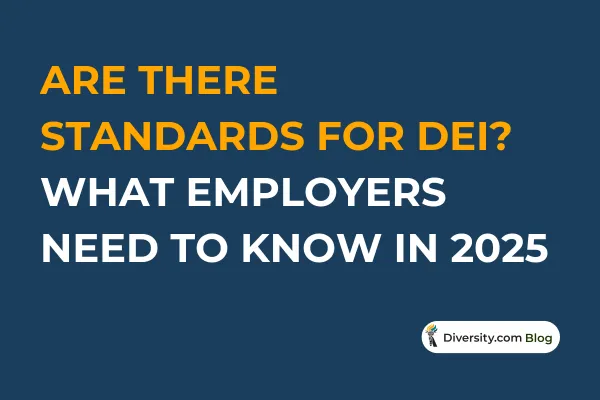
Are There Standards for DEI? What Employers Need to Know in 2025
"We care about diversity" is easy to say. But in 2025, employers are being asked to prove it.
Whether you're drafting an internal policy or applying for vendor certifications, the question comes up again and again: Are there actual standards for DEI?
The short answer: yes. But not always where or how you'd expect.
DEI doesn't follow a single universal framework, but there are clear benchmarks, best practices, and accountability tools you can use.
This article walks through where those standards come from, what they cover, and how to apply them to your workplace.
What Do We Mean by "DEI Standards"?
DEI standards are reference points, formal or informal, that help organizations:
Identify gaps in inclusion or equity
Measure progress in hiring, retention, engagement, and culture
Align internal policies with legal or ethical expectations
Benchmark against others in your industry or sector
In practice, these might look like public frameworks (like the Global DEI Benchmarks), industry-specific audits, state-level compliance requirements, or internal scorecards.
Key Frameworks and Benchmarks to Know
Here are some of the most recognized sources of DEI standards in the U.S. and globally:
Global Diversity, Equity & Inclusion Benchmarks (GDEIB): A research-backed tool outlining 275 standards across 15 categories of DEI strategy. Used internationally by organizations to assess maturity and build strategy.
EEOC and OFCCP Guidelines: Federal compliance standards tied to nondiscrimination, pay equity, and equal opportunity for federal contractors (U.S. EEOC, 2024).
SHRM and HRC Benchmarks: SHRM offers guidance on inclusive hiring and retention practices, while HRC’s Corporate Equality Index measures LGBTQ+ workplace inclusion (SHRM, 2023; HRC, 2023).
Supplier Diversity Certifications: Programs like NMSDC and WBENC offer formal criteria for minority- and women-owned business status.
What These Standards Actually Cover
While language and structure vary, most DEI standards cover these focus areas:
Representation: Who’s hired, promoted, and retained across roles
Policy: Pay equity, accessibility, anti-harassment, parental leave, and more
Leadership Accountability: Whether executives are trained and held responsible for DEI progress
Workplace Culture: Psychological safety, employee voice, and belonging
Data & Transparency: Internal metrics, progress reporting, and external disclosure
Some frameworks include maturity models, helping you assess where you are—from reactive to proactive to embedded.
What’s New in 2025?
Greater demand for third-party audits: More clients, investors, and boards are asking for independent DEI assessments.
State-level reporting laws: States like California are expanding transparency rules around pay equity and demographic disclosures.
Employee-driven standards: Gen Z workers are influencing internal standards, expecting DEI to show up in wellness programs, benefits, and flexible work policies.
How Employers Can Apply These Standards
Start with one framework. You don’t need to follow them all—choose one that aligns with your size and goals.
Build a baseline assessment. Use a DEI audit to map out your current practices and policies.
Prioritize transparency. Share progress internally and externally, even if it’s imperfect.
Involve employees. Standards work best when they reflect lived experience, not just leadership.
Final Thoughts
There’s no single checklist for DEI that fits every workplace. But there are clear standards you can draw from: tools to help you move from vague intention to steady, measurable action.
In 2025, the question isn’t whether your company says it values diversity. It’s whether there’s a structure in place to show that it does.
How Diversity.com Supports Inclusive Hiring
At Diversity.com, we know that inclusive hiring isn’t about lowering standards—it’s about raising the bar and removing outdated filters that limit potential.
That’s why we equip employers with the tools, strategies, and talent pipelines to build teams that are qualified, diverse, and forward-thinking—without compromising on excellence.
Whether you're refining your recruitment process, improving retention, or navigating new DEI challenges, we’re here to support your mission with real solutions and real results.
For Employers & HR Professionals:
✔ Create a free employer account — Start posting jobs that reflect your values. Choose from single listings, job packs (discounted credit bundles), or subscription plans tailored to your hiring needs.
✔ Access a diverse, top-tier candidates — Connect with professionals who bring both qualifications and fresh perspectives to your team.
✔ Stay informed with expert DEI insights — Learn how to apply inclusive strategies without sacrificing performance.
For Job Seekers:
✔ Explore inclusive career opportunities — Discover employers that care about merit, culture, and impact.
✔ Create a free job seeker account — Apply confidently for jobs with companies that believe in equity.
✔ Understand Inclusive Hiring — Learn how DEI really works—and how it can work for you.
We don’t lower standards. We eliminate the barriers that keep talent hidden.
Start building a better, bolder team today—with Diversity.com.
Questions? Contact Us, and we'll walk you through it.
Related Articles
You’re Not a Pity Hire: Breaking the Biggest Misconceptions About DEI
Debunking the Myth: DEI Doesn’t Mean Lowering Hiring Standards
Sources & References
Human Rights Campaign. (2023). Corporate Equality Index Report. https://www.hrc.org/resources/corporate-equality-index
SHRM. (2023). Guidelines for Inclusive Hiring and Workplace Policy. https://www.shrm.org
U.S. Equal Employment Opportunity Commission. (2024). EEO laws and regulations. https://www.eeoc.gov
The Centre for Global Inclusion. (2023). Global DEI Benchmarks. https://centreforglobalinclusion.org

